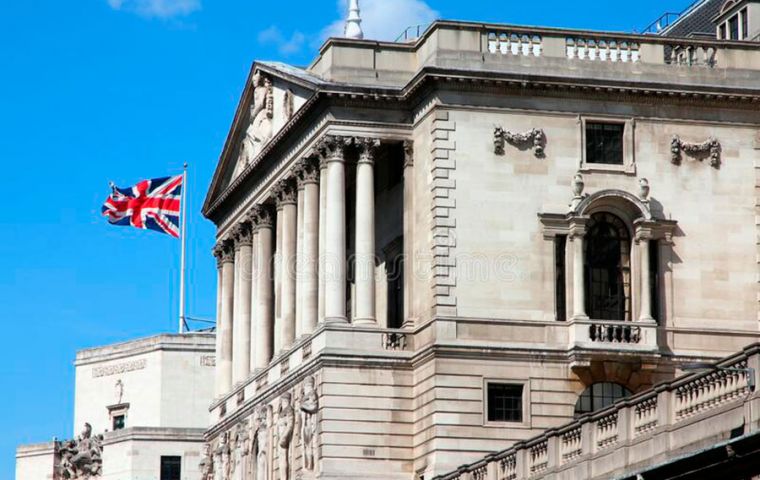MercoPress. South Atlantic News Agency
Bank of England combats inflation by increasing base rate interest to 1%
 The MPC majority voted 6-3 to increase Bank Rate by 0.25 percentage points, to 1%, while members from the minority preferred 0.5 percentage points, to 1.25%.
The MPC majority voted 6-3 to increase Bank Rate by 0.25 percentage points, to 1%, while members from the minority preferred 0.5 percentage points, to 1.25%. The Bank of England on Thursday increased for the fourth consecutive time the base rate interest to 1% in an attempt to contain inflation and despite admitting the prospect of recession. The energy crunch, the Russian war in Ukraine, and lesser household incomes are expected to contribute to weaker growth.
At the Monetary Policy Committee meeting a majority voted 6-3 to increase Bank Rate by 0.25 percentage points, to 1%, (highest borrowing cost since 2009), while members from the minority preferred to increase Bank Rate by 0.5 percentage points, to 1.25%.
MPC goes on to explain that inflationary pressures have intensified sharply following Russia’s invasion of Ukraine, with an overall material deterioration in the outlook for world and UK growth. These developments have exacerbated greatly the combination of adverse supply shocks that the UK and other countries continue to face. Concerns about further supply chain disruption have also risen, both because of the Ukraine conflict and Covid-19 developments in China.
UK GDP is estimated to have risen by 0.9% in 2022 Q1, and the unemployment rate fell to 3.8% in the three months to February, and is likely to fall slightly further in coming months. Surveys of business activity have remained strong but there are indicators of retail spending and consumer confidence that the squeeze on real disposable incomes is starting to weigh on the household sector.
Twelve-month CPI inflation rose to 7.0% in March, around 1 percentage point higher than expected in the February Report. The strength of inflation relative to the 2% target mainly reflects previous large increases in global energy and tradable goods prices, the latter of which is due to the shift in global demand towards durable goods and to supply chain disruptions.
In the May Report central projection, CPI inflation is expected to rise further over the remainder of the year, to just over 9% in 2022 Q2 and averaging slightly over 10% at its peak in 2022 Q4. The majority of that further increase reflects higher household energy prices following the large rise in the price cap in April and projected additional large increase in October. The price cap mechanism means that it takes some time for increases in wholesale gas and electricity prices, and their respective futures curves, to be reflected in retail energy prices. The expected rise in CPI inflation also reflects higher food, core goods and services prices.
UK GDP growth is expected to slow sharply over the first half of the forecast period, reflecting the adverse impact of the sharp rises in global energy and tradable goods prices on most UK households’ real incomes and many UK companies’ profit margins. Although the unemployment rate is likely to fall slightly further in the near term, it is expected to rise to 5½% in three years’ time given the sharp slowdown in demand growth.




Top Comments
Disclaimer & comment rulesCommenting for this story is now closed.
If you have a Facebook account, become a fan and comment on our Facebook Page!